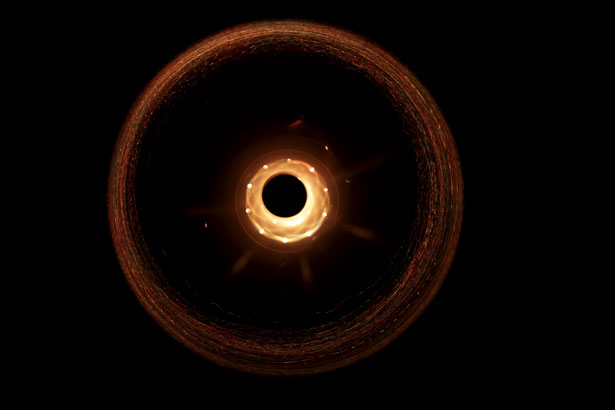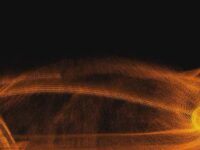Imagine if science was scrapped and rewritten in an instant. The behavior of phenomena associated with quantum physics, gravity, and black holes has historically challenged our very perception of the universe. The scientific world potentially stands on the verge of enormous advancement through the reconciliation of Albert Einstein’s theory of relativity (in part macroscopic gravitational behavior) and quantum theory (microscopic particle behavior). Different theories predict varied extents to which the scientific world might or might not change. The study of gravity and dimensions around black holes, assisted by our understanding of wormholes and string theory, facilitates this reconciliation with the proposal that the universe and reality could essentially be a hologram.
Gravity: A tale of two theories
First, a quick recap. The theory of general relativity explains how gravity acts on a macroscopic, universal scale throughout the universe as one of the four forces of physics. Gravity has yet to be applied to quantum theory, which, on a microscopic scale of atomic and subatomic particles, deals with the other three forces of physics: electromagnetic forces, strong interactions, and weak interactions. The universe’s gravitational field is commonly represented by a tablecloth (also known as the fabric of spacetime) stretched over an opening. A large marble placed in the center causes the center of the cloth to dip downward and the rest of the cloth to curve and funnel inward. When placed on the cloth, a smaller marble will accelerate toward the large marble; this “attraction” is not from an innate force, per se, but results from the cloth’s geometric properties caused by its interaction with the large marble. Unlike the physics of general relativity, the physics involved in quantum theory is based on probability and margins of error, as scientists currently cannot determine the exact trajectory of particles. Quantum theory specifically details the behavior and interactions of particles that dictate properties of matter and energy. Particle behavior is particularly useful for understanding black holes, and its incompatibility with gravity is a divide physicists have been trying to bridge. This is the long-sought realization of quantum gravity.
Particle behavior is particularly useful for understanding black holes, and its incompatibility with gravity is a divide physicists have been trying to bridge.
Some current theories of quantum gravity reconcile gravity and quantum phenomena by perceiving the universe as a hologram. This is referred to as the holographic principle. The study of black holes, which create intense gravitational fields on the scale of particles, encourages the combination of the two theories and is associated with the holographic principle. It must be noted that “holographic” refers to the representation of an N-dimensional object in less than N dimensions, similar to observing the 3D aspects of an object on a 2D television screen.
Black holes and wormholes: Paradoxical destruction
Black holes occur when massively dense stars collapse into themselves due to their significant gravity. Not only do black holes warp spacetime, they also theoretically destroy particles and particle information (the Universe’s “data” of particles), violating the laws of physics and creating a paradox. Once a particle falls into a black hole, it is seemingly impossible to get back information about what that particle was. In a 1995 issue of the Journal of Mathematical Physics, scientists proposed that the radiation escaping from the surface of black holes, itself proposed by Stephen Hawking in a 1974 issue of Nature, may be related to or even relay the information of each “destroyed” particle within the black hole back into the universe.
Once a particle falls into a black hole, it is seemingly impossible to get back information about what that particle was.
How exactly does information escape? It is not entirely clear. Unsurprisingly, the missing puzzle piece may relate to gravity’s role in quantum-level particle behavior. In a 2021 issue of the Journal of High Energy Physics, scientists conjectured that the interior of black holes may contain wormhole-like characteristics. Wormholes are shortcut tunnels to different locations in the fabric of the universe; black holes might act like wormholes by somehow projecting information from their interior to beyond their boundaries. For black holes, the projection of this information is facilitated by existing radiation from black holes. It is this idea of multidimensional projection that points toward the holographic principle.
Holographic theory: Mathematical duality
The holographic principle uses this same logic for black holes. As 3D matter falls into a black hole, the object’s information is imprinted onto the 2D plane of particles on the surface of the black hole. This information can then be “picked up” by particles radiating from the surface. In other words, black holes interact with 3D gravity and matter but their visible effects exist on the 2D particle plane, meaning black holes can essentially be viewed as 2D holograms of entities with 3D properties.
Some proponents of quantum gravity consider this connection between gravity and particles to be a form of mathematical duality where gravitational phenomena mathematically correspond to particle phenomena. In the 1990s, physicist Juan Maldacena proposed a form of mathematical duality and its holographic aspects as “Anti-de Sitter space and Conformal Field Theory correspondence” (AdS/CFT). In short, this theory refers to the relationship between gravity and quantum physics when looking at the universe in terms of quantum string theory. Imagine Anti-de Sitter space as a volume of space representing the gravitational universe. This volumetric space has a surface boundary calculated using the quantum physics of conformal field theory. In geometry, a volume of space has a higher dimension than its boundary and is mathematically related to its boundary (e.g., the volume of a 3D cylinder is mathematically related to its 2D area and its boundary). Therefore, not only does this model of the universe mathematically relate gravity to quantum physics, but it shows that information of 3D space can be related to and represented on a 2D surface akin to the holographic principle. This means that, just as black holes can be visualized as 2D holograms because of their multidimensional projections between gravity and particles, the rest of the universe could be visualized as an informational hologram because of the multidimensional mathematics of a model relating gravity and quantum physics.
Recent advancements
As of March 2022, papers in Physics Letters B and Physical Review Letters have produced more concrete support for the “quantum hair” explanation for how information could be projected from black holes and thus how gravity and quantum physics could be reconciled with the holographic principle. “Hair” is the term used for the imprint on the gravitational field made by a black hole’s radiative and informational aftereffects. If true, this landmark discovery could eliminate the need to re-envision the foundations of physics in order to relate gravity to particles since quantum-state information is more directly related to imprints on a now quantized gravitational field without rewriting quantum theory or gravity theory. Hawking, himself, doubted that chaotic radiation could be the exact means by which information is preserved and later considered quantum hair and its assumption of less chaotic radiation to be the missing link, but he lacked support. Scientists have finally found more mathematical evidence that black holes have this “hair,” resulting in some hope that this entire phenomenon could be the true realization of quantum gravity.
This landmark discovery could eliminate the need to re-envision the foundations of physics in order to relate gravity to particles
The whole picture
In truth, this article barely scratches the surface of all these topics; however, the relevance of quantum gravity, particularly in light of recent developments regarding black holes, is undeniable. Holographic theory is just one of many existential theories about the Universe. True to its nature, the world of quantum mechanics is rich with possibilities that computers and artificial intelligence have only just begun to help us explore. There are innumerable caveats and nuances and holes in these discoveries, but they allow science to keep moving forward, to keep moving down the rabbit hole.
International Journal of Theoretical Physics (1999). DOI: 10.1023/A:1026654312961
Journal of High Energy Physics (2021). DOI: 10.1007/JHEP04(2021)289
Journal of Mathematical Physics (1995). DOI: 10.1063/1.531249
Nature (1974). DOI: 10.1038/248030a0
Nature Communications (2022). DOI: 10.1038/s41467-021-27951-9
Physical Review Letters (2022). DOI: DOI: 10.1103/PhysRevLett.128.111301
Physics Letters B (2022): DOI: 10.1016/j.physletb.2022.136995
PRX Quantum (2022). DOI: 10.1103/PRXQuantum.3.010324




